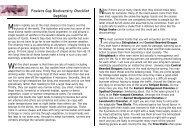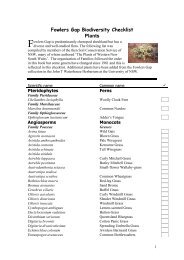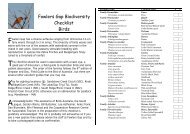2007 Research Reports.pdf - Fowlers Gap Arid Zone Research Station
2007 Research Reports.pdf - Fowlers Gap Arid Zone Research Station
2007 Research Reports.pdf - Fowlers Gap Arid Zone Research Station
Create successful ePaper yourself
Turn your PDF publications into a flip-book with our unique Google optimized e-Paper software.
1.10 Barrier Ranges Sustainable Wildlife Enterprise Trial<br />
Investigators: P Ampt 1 , A Baumber 1 , R Cooney 1 , K Gepp 2<br />
1 Future of Australia’s Threatened Ecosystems (FATE) Program, Institute of<br />
Environmental Studies, UNSW,<br />
2 Western CMA, Broken Hill<br />
For three years the FATE Program has been working towards achieving multiple benefits by<br />
applying conservation through sustainable use (CSU) approaches to the kangaroo industry. A<br />
critical component is landholder involvement in kangaroo management that results in<br />
commercial gain. We are developing strategies for landholders to add value to the harvest at the<br />
same time as achieving better control of the impact that kangaroos can have on their land. We<br />
have sought close collaboration between members of the Barrier Area Rangecare Group<br />
(BARG), harvesters, processors and regulators to achieve this end.<br />
The Barrier Ranges Sustainable Wildlife Enterprise Trial is part of a larger program funded by<br />
RIRDC to develop Sustainable Wildlife Industries (SWEs) in the rangelands. Progress on this<br />
trial to date includes:<br />
• analysis of harvest data across collaborating BARG properties;<br />
• discussions between stakeholders and other groups seeking similar outcomes;<br />
• the commencement in May 2008 of a trial under the adaptive management provisions o f<br />
the Kangaroo Management Program of the use of a General Licence for participating<br />
BARG properties and kangaroo harvesters, whereby harvest tags are allocated to the<br />
group rather than to individual properties. This trial involves 15 landholders and 16<br />
harvesters and covers more than 900,000ha.<br />
• Working with a steering committee to develop a business plan for an enterprise to manage<br />
harvest and chillers for the group;<br />
• training of landholders in Landscape Function Analysis (LFA) and working with them to<br />
develop group environmental monitoring based on LFA to facilitate adaptive<br />
management by landholders.<br />
<strong>Fowlers</strong> <strong>Gap</strong> is an integral part of this trial. We have conducted LFA training on <strong>Fowlers</strong> <strong>Gap</strong><br />
and on neighbouring properties and will use several locations on FG as reference sites. For<br />
example Emu paddock inside the exclosure is a site which provides the upper level of a dynamic<br />
range for its land type. Also FG is included in the General Licence as a non-harvest zone, and<br />
David Croft is a member of the Steering Committee. As a result of this work we are developing<br />
and trialling a system that integrates kangaroo management with good land management for the<br />
benefit of the rangelands and rangeland communities.<br />
Publications and theses 2000<strong>2007</strong><br />
2000:<br />
Croft DB (2000) Sustainable use of wildlife in western New South Wales: Possibilities and problems. Rangeland<br />
Journal 22, 88-104.<br />
Dawson TJ, Blaney CE, Munn AJ, Krockenberger AK, Maloney SK (2000) Thermoregulation by kangaroos from<br />
mesic and arid habitats: influence of temperature on routes of heat loss in grey kangaroos (Macropus giganteus) and<br />
red kangaroos (Macropus rufus). Physiological and Biochemical Zoology 73, 374-381.






